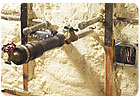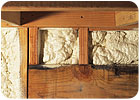
SPF seals pipes and through-the-wall plumbing penetrations.
With the increasing demand for energy efficiency, better air quality and mold prevention, builders and insulation contractors are seeking better methods of insulation that ultimately offer the homeowner economic benefits.
Fiberglass batts or rolls and blown-in cellulose are the most familiar choices of insulation. Today, however, spray polyurethane closed-cell foam insulation is becoming more commonplace. Spray polyurethane foam (SPF) insulation creates an airtight seal that results in considerable benefits to a home’s fuel efficiency, air quality and structural integrity. It also contributes to mold prevention, a large concern among today’s builders, contractors and homeowners.
Installing SPF insulation requires specific equipment and proper training. Additionally, adequate protection is needed, as SPF insulation poses some minimal respiratory hazards during the initial spraying or installation stage. Once installation techniques and safety procedures become familiar, contractors will find that SPF is easy to install and will contribute to greater energy economy for the consumer.

Self-adhesive spray seals small, tight spaces, underside of roof sheathing and floor boards.
Investing in energy efficiency
Even though SPF typically costs the consumer more, reduced energy costs will exceed the value of the initial investment. U.S. Department of Energy (DOE) studies have found that heating and cooling account for 50 to 70 percent of the energy used in a typical home. According to the U.S. Government Energy Laboratory, as much as 40 percent of heating and cooling energy is wasted on compensating for air infiltration in buildings.The “Honeywell Report, Residential Insulation Case Studies,” has demonstrated that homeowners with SPF insulation can save 38 to 48 percent in utility bills, with savings as high as 58 percent for homeowners with propane heating. One case study, for example, was of a homeowner who assumed an additional $58 in his monthly mortgage payment to finance SPF insulation. However, he saved $108 on his monthly heating and cooling bills.
Fiberglass and blown-in cellulose can leave cracks, crevices and leaks in a typical house, no matter how well the insulation is installed. SPF, however, expands upon contact to form an airtight seal. The R-Value, which measures resistance to heat transfer, is 6.5 per one inch of thickness for SPF, in comparison to 3.7 for blown-in cellulose and 3.4 for fiberglass batts.
By creating an airtight, seamless and rigid seal, SPF insulation eliminates convection currents, the leading cause of heat loss, and maintains a comfortable constant temperature that results in greater energy efficiency. An airtight insulation seal also allows for a smaller heating, ventilation and air conditioning (HVAC) system, resulting in further reductions of energy costs.
The airtight seal of SPF insulation also increases the energy efficiency of air conditioning, which is particularly significant in areas such as the Southwestern United States, where hot weather is normal for most of the year. Contractors are installing SPF insulation in residential buildings more frequently in these climates to meet the demand for more energy-efficient cooling.
Improving air quality
In addition to reducing energy costs, SPF insulation offers the homeowner other benefits that include better air quality, inhibition of rot and mold, greater structural integrity and noise reduction.Controlling a building’s mechanical ventilation significantly affects its interior air quality. According to the U.S. Environmental Protection Agency (EPA), the concentration of pollutants in the interior air of a building can be two to five times greater than that of outdoor air. The airtight seal of SPF insulation, however, enables a standard air recycler to function effectively to replace polluted internal air with clean air.
Additionally, the airtight seal that SPF provides inhibits vapor and resists the permeation of moisture through walls and roofs. Interior moisture is the leading cause of building damage.
By eliminating the condensation of moisture in interior spaces, SPF helps prevent the deterioration of insulation and the decay of framing members. Additionally, SPF is being used more frequently to insulate wine cellars, which require environments with not only consistent temperatures but also low moisture.
Reducing the amount of internal moisture also reduces the growth of mold, which poses a health risk, especially to people with allergies, asthma and other respiratory conditions.
In addition to improving the quality of a building’s interior environment, SPF contributes to the structural integrity of the building itself. When cured, SPF insulation fortifies the walls it insulates, providing additional structural strength, which is particularly beneficial for buildings located in areas subject to earthquakes or hurricanes.
SPF also helps deaden external noise pollution, such as traffic, trains, airplanes and construction.
Unlike some conventional methods of insulation, SPF requires professional installation. The need for spray rig equipment and the hazards posed by chemicals used to cure SPF preclude homeowners from assuming the task of installation themselves. Even though professional contractors are not competing against do-it-yourselfers for installation work, they must invest in the proper training and equipment in order to install SPF safely and properly.
Box trucks and trailers
Contractors may choose between two types of spray rigs: box trucks and trailers. Box trucks offer a range of sizes from 16 to 28 feet in overall length, with cargo space for taking equipment from one job site to another. Trailer rigs are available as gooseneck trailers, which hook onto a fifth wheel attachment at the center of the truck bed, or as tag trailers, which are smaller at 16 to 24 feet and hook to the back bumper of a truck. While many contractors find the box trucks easier to maneuver, others find that trailers offer the flexibility of leaving the spray rig at one site without having to take it to another site where it’s not needed.In addition to spray rigs, contractors must have the appropriate safety equipment to protect themselves from chemicals, gas, vapors and particulates. Diisocyanates, for example, are used as curing agents for SPF, but could pose respiratory hazards.
Diisocyanate levels for SPF insulation jobs typically exceed the Occupational Safety and Health Administration (OSHA) Permissible Exposure Limit (PEL). In addition to ensuring that the job site is adequately ventilated, contractors must use the proper respiratory protection.
When selecting the appropriate respiratory protection, the contractor should consider the air concentration of various contaminants in the spray mix. Air monitoring is one example of assessing the concentration of contaminants, and uses a calibrated pump system. The contractor will know then what level of protection is required of the respiratory protection equipment.
Advances in SPF have enabled contractors to install it under a wider range of climate conditions. Some manufacturers have refined SPF so that it may be installed in cooler ambient temperatures, reducing the number of occasions when weather conditions will interfere with completing jobs.
Warmer temperatures require additional preparation of the work area and the SPF material to ensure the proper adherence and curing. Among these precautions is to avoid storing “B” drums in direct sunlight. Exposure to direct sunlight may increase the foam’s temperature by as much as 40 degrees Fahrenheit and cause boil-over. “B” drums also should be kept away from air compressors and generators, as their radiant heat also may damage the SPF material before installation. When installing, the contractor should open the “B” drums slowly, and preferably, open them as early as possible on the day of installation.
In summary, SPF insulation provides various benefits to homeowners, such as significant energy savings, improved air quality, reduced risk of wood rot and mold growth, and reinforced structural integrity. The contractor, however, must be adequately trained and have the appropriate safety and installation equipment to deliver these benefits.


Report Abusive Comment